Alfa Romeo 4C 2015 Owner handbook (in English)
Manufacturer: ALFA ROMEO, Model Year: 2015, Model line: 4C, Model: Alfa Romeo 4C 2015Pages: 199, PDF Size: 7.67 MB
Page 31 of 199
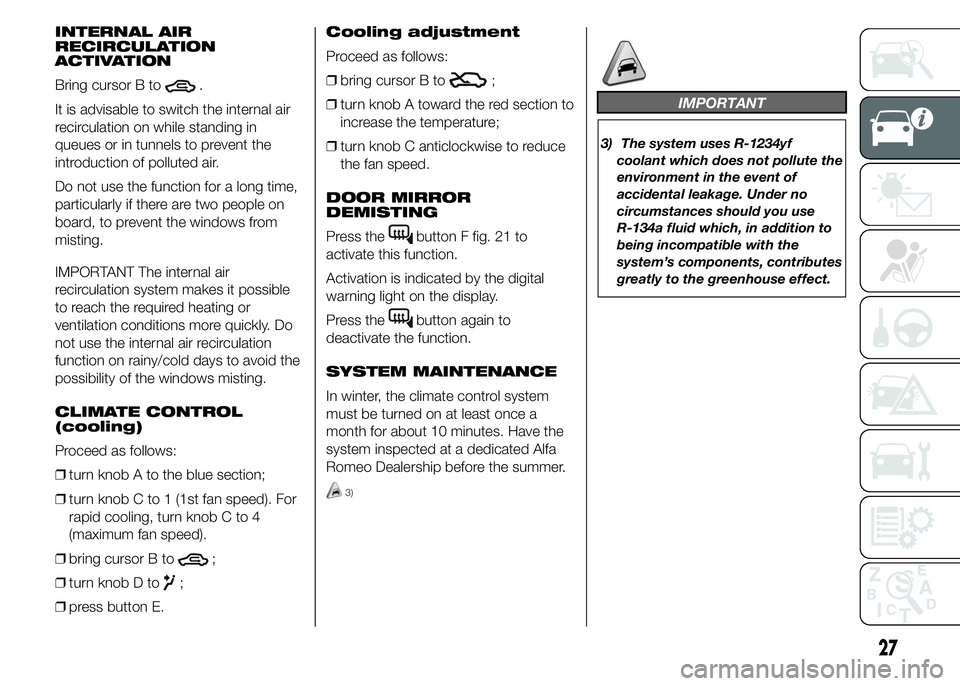
INTERNAL AIR
RECIRCULATION
ACTIVATION
Bring cursor B to
.
It is advisable to switch the internal air
recirculation on while standing in
queues or in tunnels to prevent the
introduction of polluted air.
Do not use the function for a long time,
particularly if there are two people on
board, to prevent the windows from
misting.
IMPORTANT The internal air
recirculation system makes it possible
to reach the required heating or
ventilation conditions more quickly. Do
not use the internal air recirculation
function on rainy/cold days to avoid the
possibility of the windows misting.
CLIMATE CONTROL
(cooling)
Proceed as follows:
❒turn knob A to the blue section;
❒turn knob C to 1 (1st fan speed). For
rapid cooling, turn knob C to 4
(maximum fan speed).
❒bring cursor B to
;
❒turn knob D to
;
❒press button E.Cooling adjustment
Proceed as follows:
❒bring cursor B to
;
❒turn knob A toward the red section to
increase the temperature;
❒turn knob C anticlockwise to reduce
the fan speed.
DOOR MIRROR
DEMISTING
Press the
button F fig. 21 to
activate this function.
Activation is indicated by the digital
warning light on the display.
Press the
button again to
deactivate the function.
SYSTEM MAINTENANCE
In winter, the climate control system
must be turned on at least once a
month for about 10 minutes. Have the
system inspected at a dedicated Alfa
Romeo Dealership before the summer.
3)
IMPORTANT
3) The system uses R-1234yf
coolant which does not pollute the
environment in the event of
accidental leakage. Under no
circumstances should you use
R-134a fluid which, in addition to
being incompatible with the
system’s components, contributes
greatly to the greenhouse effect.
.
27
Page 32 of 199
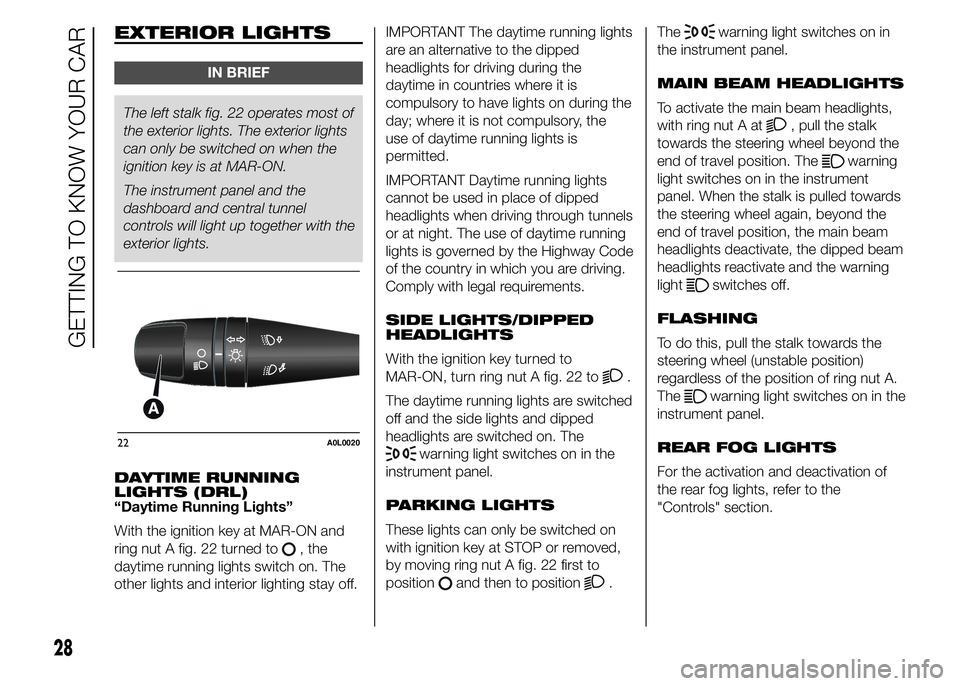
EXTERIOR LIGHTS
IN BRIEF
The left stalk fig. 22 operates most of
the exterior lights. The exterior lights
can only be switched on when the
ignition key is at MAR-ON.
The instrument panel and the
dashboard and central tunnel
controls will light up together with the
exterior lights.
DAYTIME RUNNING
LIGHTS (DRL)
“Daytime Running Lights”
With the ignition key at MAR-ON and
ring nut A fig. 22 turned to
, the
daytime running lights switch on. The
other lights and interior lighting stay off.IMPORTANT The daytime running lights
are an alternative to the dipped
headlights for driving during the
daytime in countries where it is
compulsory to have lights on during the
day; where it is not compulsory, the
use of daytime running lights is
permitted.
IMPORTANT Daytime running lights
cannot be used in place of dipped
headlights when driving through tunnels
or at night. The use of daytime running
lights is governed by the Highway Code
of the country in which you are driving.
Comply with legal requirements.
SIDE LIGHTS/DIPPED
HEADLIGHTS
With the ignition key turned to
MAR-ON, turn ring nut A fig. 22 to
.
The daytime running lights are switched
off and the side lights and dipped
headlights are switched on. The
warning light switches on in the
instrument panel.
PARKING LIGHTS
These lights can only be switched on
with ignition key at STOP or removed,
by moving ring nut A fig. 22 first to
position
and then to position.The
warning light switches on in
the instrument panel.
MAIN BEAM HEADLIGHTS
To activate the main beam headlights,
with ring nut A at
, pull the stalk
towards the steering wheel beyond the
end of travel position. The
warning
light switches on in the instrument
panel. When the stalk is pulled towards
the steering wheel again, beyond the
end of travel position, the main beam
headlights deactivate, the dipped beam
headlights reactivate and the warning
light
switches off.
FLASHING
To do this, pull the stalk towards the
steering wheel (unstable position)
regardless of the position of ring nut A.
The
warning light switches on in the
instrument panel.
REAR FOG LIGHTS
For the activation and deactivation of
the rear fog lights, refer to the
"Controls" section.
22A0L0020
28
GETTING TO KNOW YOUR CAR
Page 33 of 199
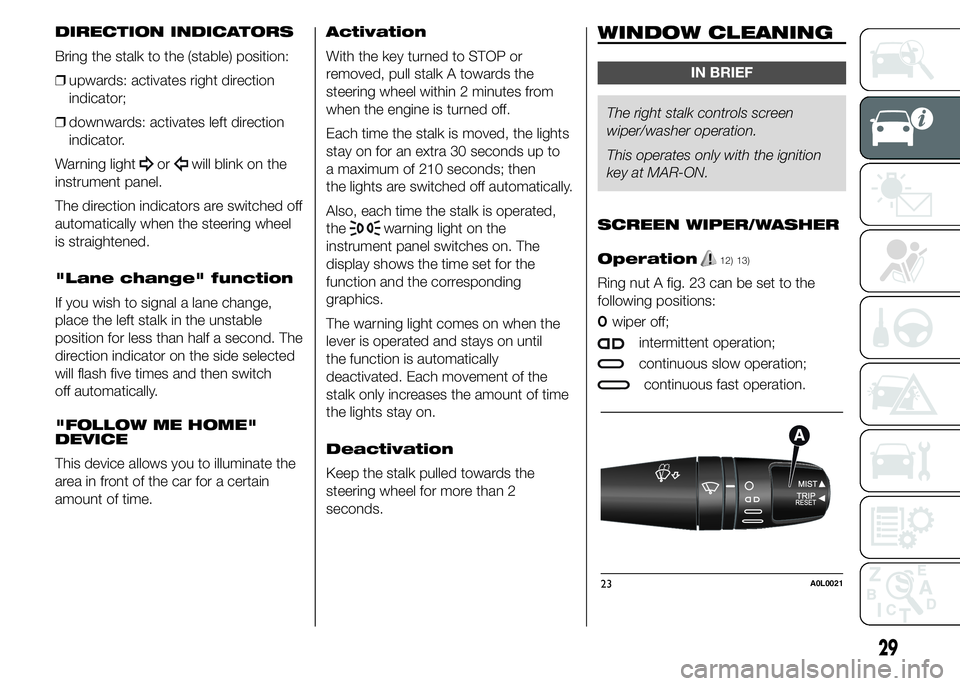
DIRECTION INDICATORS
Bring the stalk to the (stable) position:
❒upwards: activates right direction
indicator;
❒downwards: activates left direction
indicator.
Warning light
orwill blink on the
instrument panel.
The direction indicators are switched off
automatically when the steering wheel
is straightened.
"Lane change" function
If you wish to signal a lane change,
place the left stalk in the unstable
position for less than half a second. The
direction indicator on the side selected
will flash five times and then switch
off automatically.
"FOLLOW ME HOME"
DEVICE
This device allows you to illuminate the
area in front of the car for a certain
amount of time.Activation
With the key turned to STOP or
removed, pull stalk A towards the
steering wheel within 2 minutes from
when the engine is turned off.
Each time the stalk is moved, the lights
stay on for an extra 30 seconds up to
a maximum of 210 seconds; then
the lights are switched off automatically.
Also, each time the stalk is operated,
the
warning light on the
instrument panel switches on. The
display shows the time set for the
function and the corresponding
graphics.
The warning light comes on when the
lever is operated and stays on until
the function is automatically
deactivated. Each movement of the
stalk only increases the amount of time
the lights stay on.
Deactivation
Keep the stalk pulled towards the
steering wheel for more than 2
seconds.
WINDOW CLEANING
IN BRIEF
The right stalk controls screen
wiper/washer operation.
This operates only with the ignition
key at MAR-ON.
SCREEN WIPER/WASHER
Operation
12) 13)
Ring nut A fig. 23 can be set to the
following positions:
Owiper off;
intermittent operation;
continuous slow operation;
continuous fast operation.
23A0L0021
29
Page 34 of 199
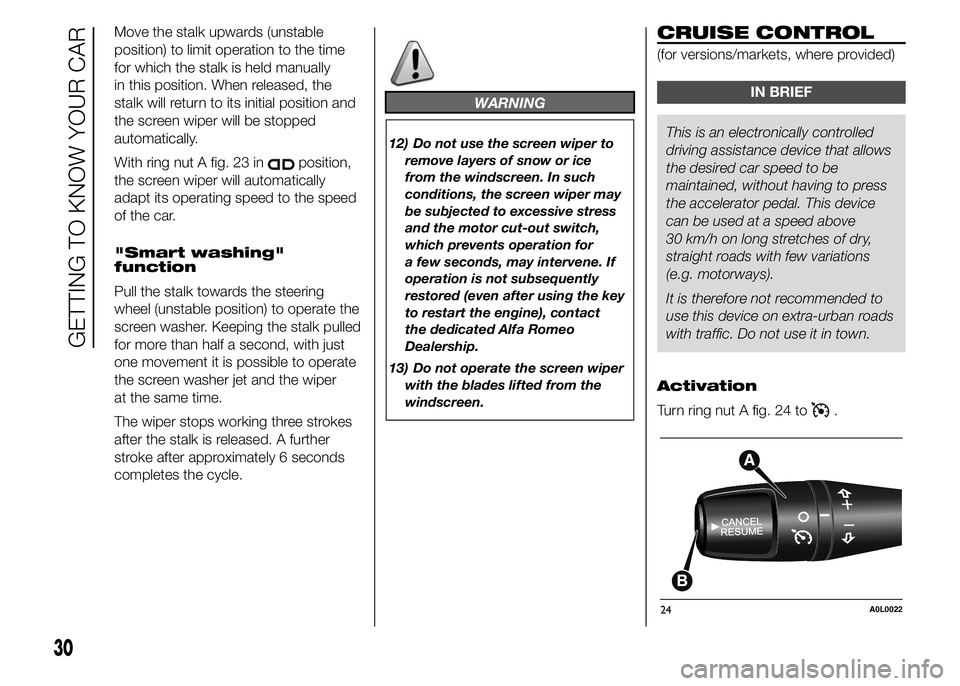
Move the stalk upwards (unstable
position) to limit operation to the time
for which the stalk is held manually
in this position. When released, the
stalk will return to its initial position and
the screen wiper will be stopped
automatically.
With ring nut A fig. 23 in
position,
the screen wiper will automatically
adapt its operating speed to the speed
of the car.
"Smart washing"
function
Pull the stalk towards the steering
wheel (unstable position) to operate the
screen washer. Keeping the stalk pulled
for more than half a second, with just
one movement it is possible to operate
the screen washer jet and the wiper
at the same time.
The wiper stops working three strokes
after the stalk is released. A further
stroke after approximately 6 seconds
completes the cycle.
WARNING
12) Do not use the screen wiper to
remove layers of snow or ice
from the windscreen. In such
conditions, the screen wiper may
be subjected to excessive stress
and the motor cut-out switch,
which prevents operation for
a few seconds, may intervene. If
operation is not subsequently
restored (even after using the key
to restart the engine), contact
the dedicated Alfa Romeo
Dealership.
13) Do not operate the screen wiper
with the blades lifted from the
windscreen.
CRUISE CONTROL
(for versions/markets, where provided)
IN BRIEF
This is an electronically controlled
driving assistance device that allows
the desired car speed to be
maintained, without having to press
the accelerator pedal. This device
can be used at a speed above
30 km/h on long stretches of dry,
straight roads with few variations
(e.g. motorways).
It is therefore not recommended to
use this device on extra-urban roads
with traffic. Do not use it in town.
Activation
Turn ring nut A fig. 24 to
.
24A0L0022
30
GETTING TO KNOW YOUR CAR
Page 35 of 199
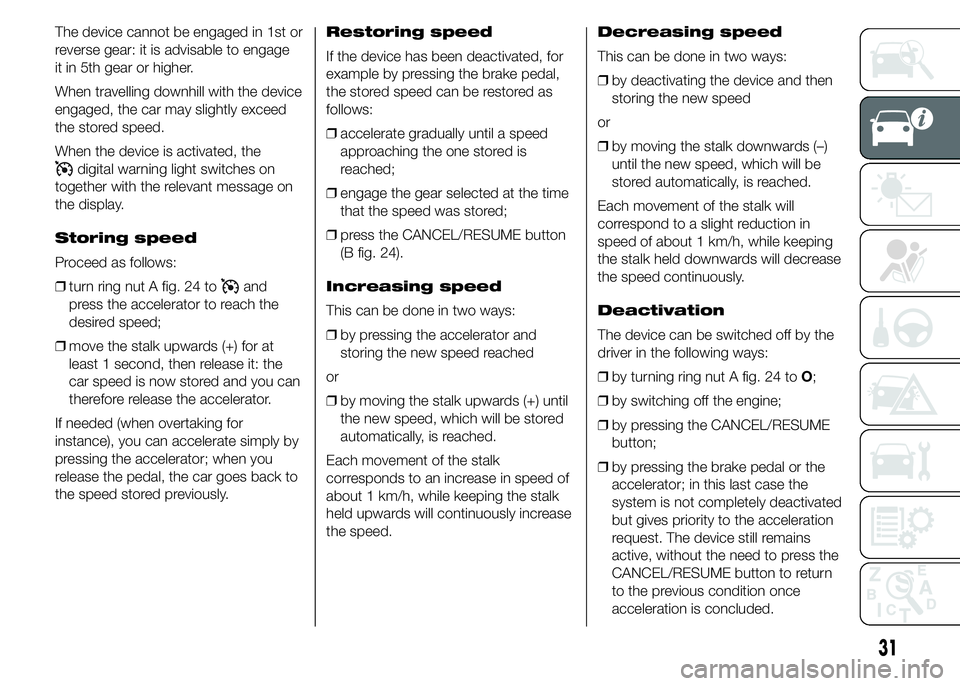
The device cannot be engaged in 1st or
reverse gear: it is advisable to engage
it in 5th gear or higher.
When travelling downhill with the device
engaged, the car may slightly exceed
the stored speed.
When the device is activated, the
digital warning light switches on
together with the relevant message on
the display.
Storing speed
Proceed as follows:
❒turn ring nut A fig. 24 to
and
press the accelerator to reach the
desired speed;
❒move the stalk upwards (+) for at
least 1 second, then release it: the
car speed is now stored and you can
therefore release the accelerator.
If needed (when overtaking for
instance), you can accelerate simply by
pressing the accelerator; when you
release the pedal, the car goes back to
the speed stored previously.Restoring speed
If the device has been deactivated, for
example by pressing the brake pedal,
the stored speed can be restored as
follows:
❒accelerate gradually until a speed
approaching the one stored is
reached;
❒engage the gear selected at the time
that the speed was stored;
❒press the CANCEL/RESUME button
(B fig. 24).
Increasing speed
This can be done in two ways:
❒by pressing the accelerator and
storing the new speed reached
or
❒by moving the stalk upwards (+) until
the new speed, which will be stored
automatically, is reached.
Each movement of the stalk
corresponds to an increase in speed of
about 1 km/h, while keeping the stalk
held upwards will continuously increase
the speed.Decreasing speed
This can be done in two ways:
❒by deactivating the device and then
storing the new speed
or
❒by moving the stalk downwards (–)
until the new speed, which will be
stored automatically, is reached.
Each movement of the stalk will
correspond to a slight reduction in
speed of about 1 km/h, while keeping
the stalk held downwards will decrease
the speed continuously.
Deactivation
The device can be switched off by the
driver in the following ways:
❒by turning ring nut A fig. 24 toO;
❒by switching off the engine;
❒by pressing the CANCEL/RESUME
button;
❒by pressing the brake pedal or the
accelerator; in this last case the
system is not completely deactivated
but gives priority to the acceleration
request. The device still remains
active, without the need to press the
CANCEL/RESUME button to return
to the previous condition once
acceleration is concluded.
31
Page 36 of 199
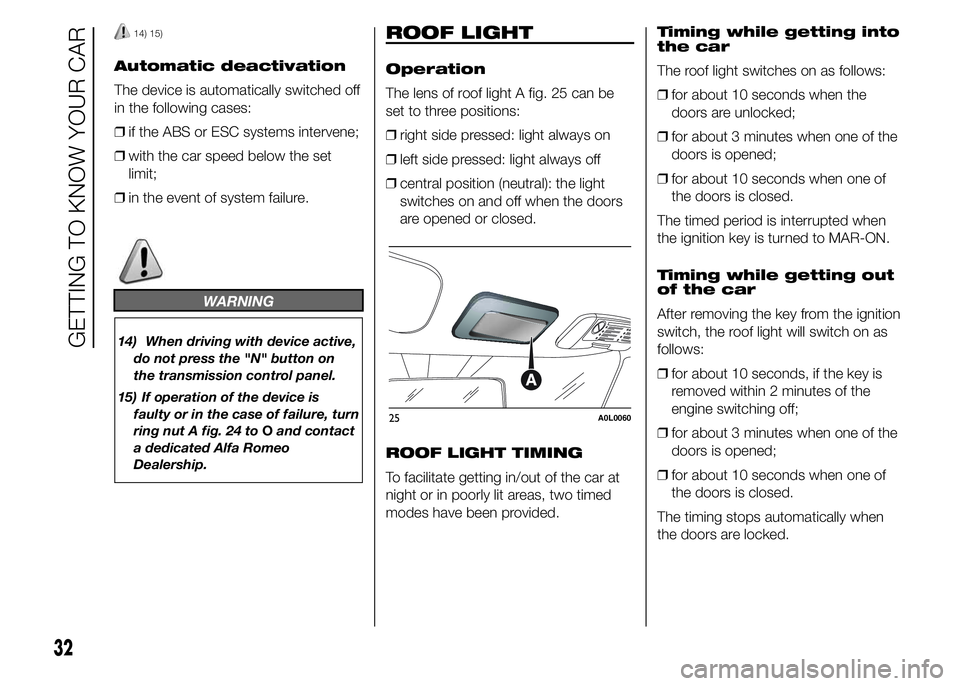
14) 15)
Automatic deactivation
The device is automatically switched off
in the following cases:
❒if the ABS or ESC systems intervene;
❒with the car speed below the set
limit;
❒in the event of system failure.
WARNING
14) When driving with device active,
do not press the "N" button on
the transmission control panel.
15) If operation of the device is
faulty or in the case of failure, turn
ring nut A fig. 24 toOand contact
a dedicated Alfa Romeo
Dealership.
ROOF LIGHT
Operation
The lens of roof light A fig. 25 can be
set to three positions:
❒right side pressed: light always on
❒left side pressed: light always off
❒central position (neutral): the light
switches on and off when the doors
are opened or closed.
ROOF LIGHT TIMING
To facilitate getting in/out of the car at
night or in poorly lit areas, two timed
modes have been provided.Timing while getting into
the car
The roof light switches on as follows:
❒for about 10 seconds when the
doors are unlocked;
❒for about 3 minutes when one of the
doors is opened;
❒for about 10 seconds when one of
the doors is closed.
The timed period is interrupted when
the ignition key is turned to MAR-ON.
Timing while getting out
of the car
After removing the key from the ignition
switch, the roof light will switch on as
follows:
❒for about 10 seconds, if the key is
removed within 2 minutes of the
engine switching off;
❒for about 3 minutes when one of the
doors is opened;
❒for about 10 seconds when one of
the doors is closed.
The timing stops automatically when
the doors are locked.
25A0L0060
32
GETTING TO KNOW YOUR CAR
Page 37 of 199
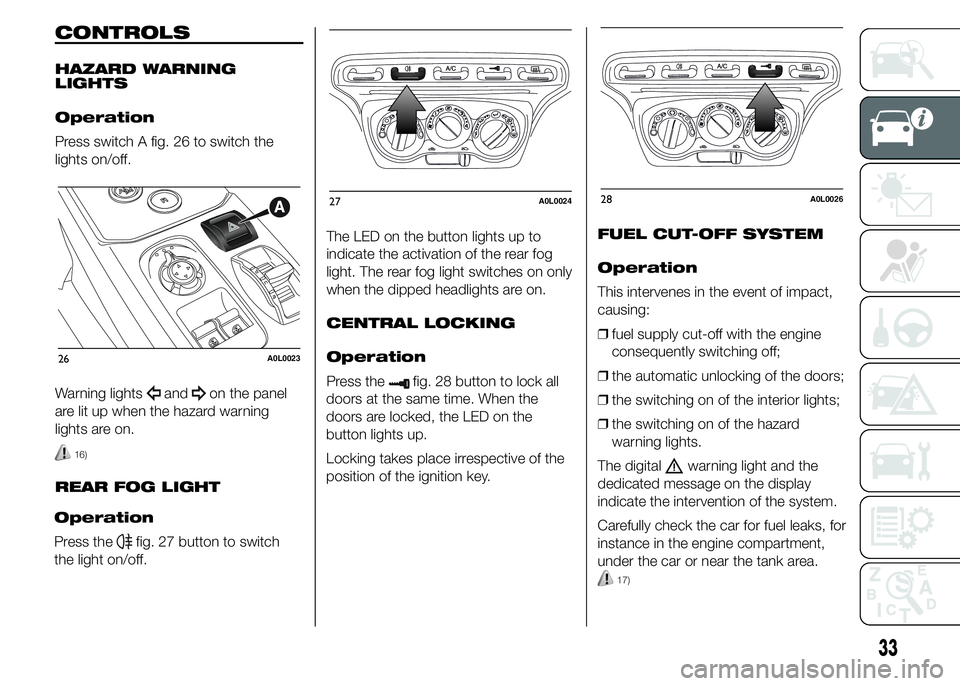
CONTROLS
HAZARD WARNING
LIGHTS
Operation
Press switch A fig. 26 to switch the
lights on/off.
Warning lights
andon the panel
are lit up when the hazard warning
lights are on.
16)
REAR FOG LIGHT
Operation
Press the
fig. 27 button to switch
the light on/off.The LED on the button lights up to
indicate the activation of the rear fog
light. The rear fog light switches on only
when the dipped headlights are on.
CENTRAL LOCKING
Operation
Press the
fig. 28 button to lock all
doors at the same time. When the
doors are locked, the LED on the
button lights up.
Locking takes place irrespective of the
position of the ignition key.FUEL CUT-OFF SYSTEM
Operation
This intervenes in the event of impact,
causing:
❒fuel supply cut-off with the engine
consequently switching off;
❒the automatic unlocking of the doors;
❒the switching on of the interior lights;
❒the switching on of the hazard
warning lights.
The digital
warning light and the
dedicated message on the display
indicate the intervention of the system.
Carefully check the car for fuel leaks, for
instance in the engine compartment,
under the car or near the tank area.
17)
26A0L0023
27A0L002428A0L0026
33
Page 38 of 199
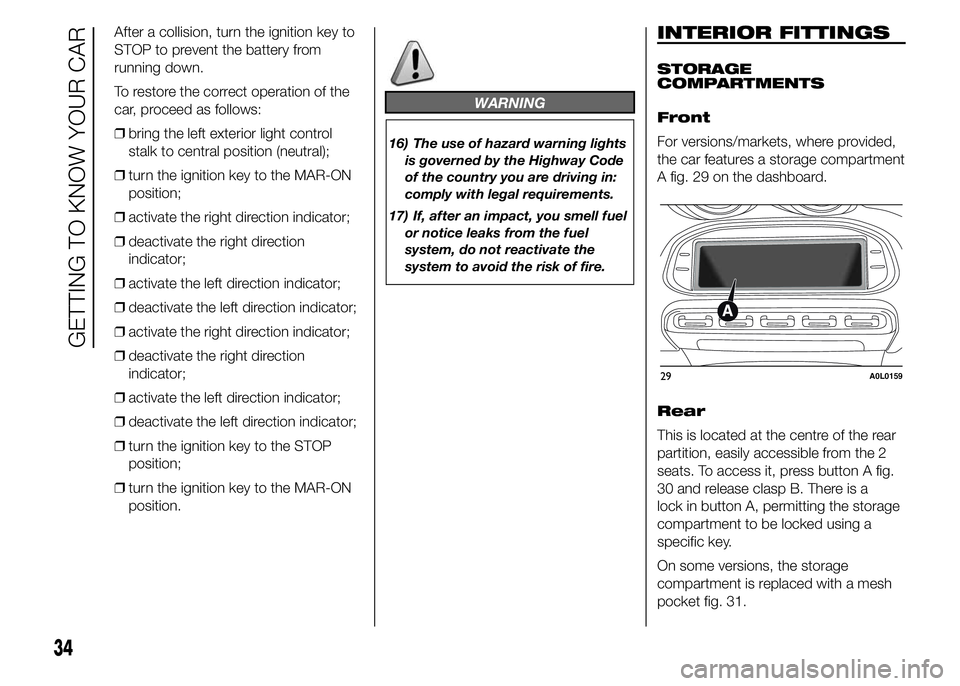
After a collision, turn the ignition key to
STOP to prevent the battery from
running down.
To restore the correct operation of the
car, proceed as follows:
❒bring the left exterior light control
stalk to central position (neutral);
❒turn the ignition key to the MAR-ON
position;
❒activate the right direction indicator;
❒deactivate the right direction
indicator;
❒activate the left direction indicator;
❒deactivate the left direction indicator;
❒activate the right direction indicator;
❒deactivate the right direction
indicator;
❒activate the left direction indicator;
❒deactivate the left direction indicator;
❒turn the ignition key to the STOP
position;
❒turn the ignition key to the MAR-ON
position.
WARNING
16) The use of hazard warning lights
is governed by the Highway Code
of the country you are driving in:
comply with legal requirements.
17) If, after an impact, you smell fuel
or notice leaks from the fuel
system, do not reactivate the
system to avoid the risk of fire.
INTERIOR FITTINGS
STORAGE
COMPARTMENTS
Front
For versions/markets, where provided,
the car features a storage compartment
A fig. 29 on the dashboard.
Rear
This is located at the centre of the rear
partition, easily accessible from the 2
seats. To access it, press button A fig.
30 and release clasp B. There is a
lock in button A, permitting the storage
compartment to be locked using a
specific key.
On some versions, the storage
compartment is replaced with a mesh
pocket fig. 31.
29A0L0159
34
GETTING TO KNOW YOUR CAR
Page 39 of 199
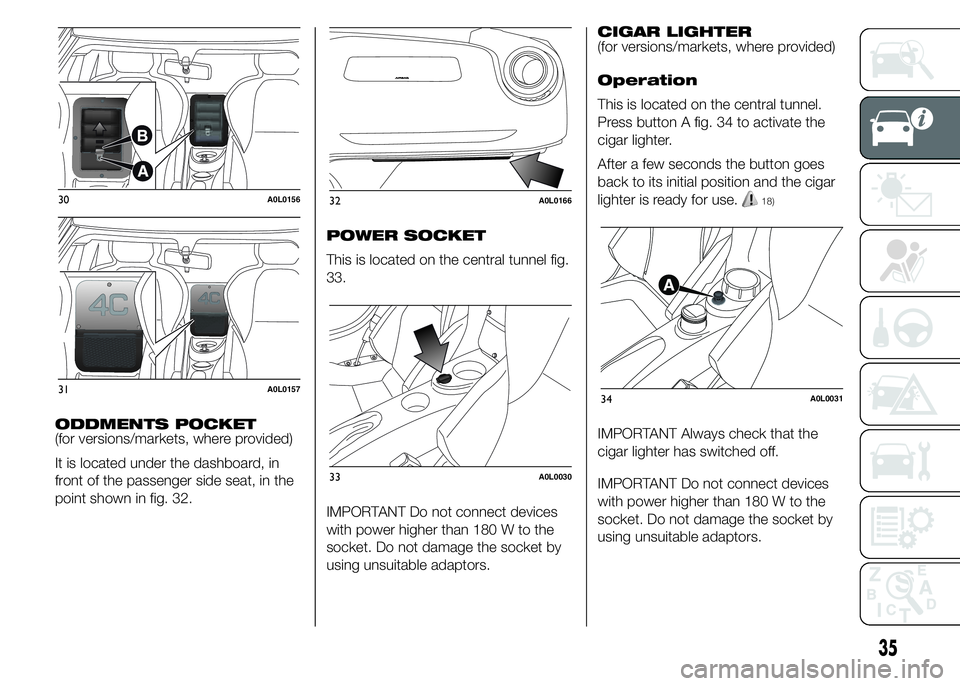
ODDMENTS POCKET
(for versions/markets, where provided)
It is located under the dashboard, in
front of the passenger side seat, in the
point shown in fig. 32.POWER SOCKET
This is located on the central tunnel fig.
33.
IMPORTANT Do not connect devices
with power higher than 180 W to the
socket. Do not damage the socket by
using unsuitable adaptors.CIGAR LIGHTER
(for versions/markets, where provided)
Operation
This is located on the central tunnel.
Press button A fig. 34 to activate the
cigar lighter.
After a few seconds the button goes
back to its initial position and the cigar
lighter is ready for use.
18)
IMPORTANT Always check that the
cigar lighter has switched off.
IMPORTANT Do not connect devices
with power higher than 180 W to the
socket. Do not damage the socket by
using unsuitable adaptors.
30A0L0156
31A0L0157
32A0L0166
33A0L0030
34A0L0031
35
Page 40 of 199
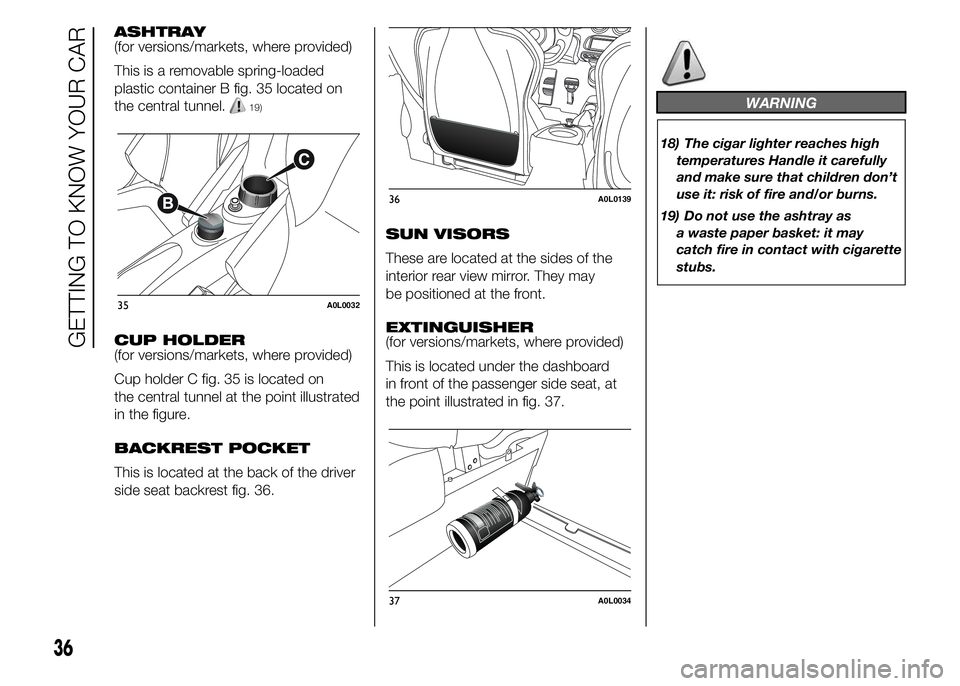
ASHTRAY
(for versions/markets, where provided)
This is a removable spring-loaded
plastic container B fig. 35 located on
the central tunnel.
19)
CUP HOLDER
(for versions/markets, where provided)
Cup holder C fig. 35 is located on
the central tunnel at the point illustrated
in the figure.
BACKREST POCKET
This is located at the back of the driver
side seat backrest fig. 36.SUN VISORS
These are located at the sides of the
interior rear view mirror. They may
be positioned at the front.
EXTINGUISHER
(for versions/markets, where provided)
This is located under the dashboard
in front of the passenger side seat, at
the point illustrated in fig. 37.
WARNING
18) The cigar lighter reaches high
temperatures Handle it carefully
and make sure that children don’t
use it: risk of fire and/or burns.
19) Do not use the ashtray as
a waste paper basket: it may
catch fire in contact with cigarette
stubs.
35A0L0032
36A0L0139
37A0L0034
36
GETTING TO KNOW YOUR CAR